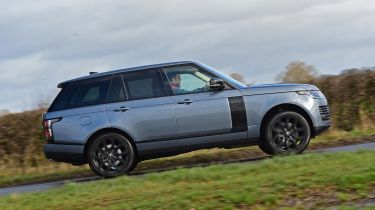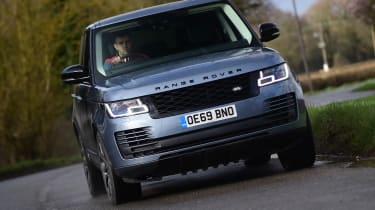Range Rover SUV (2012-2022) - MPG, running costs & CO2
If you’re worried about fuel economy, chances are you’re probably not after a big luxury 4x4. The Range Rover is expensive to buy and run.
Despite Land Rover's best efforts to lighten the Range Rover, it's still an absolutely huge car and as a result, it's still heavy. Factor in the poor aerodynamics of its tall, boxy shape, and it's clear the Range Rover will struggle to deliver impressive economy and emissions. Yet, in a test of the run-out Westminster model fitted with the D300 diesel engine, we managed nearly 40mpg - impressive for a large luxury SUV.
Range Rover MPG & CO2
While the latest Range Rover is the most fuel-efficient yet, we’re still talking about a car with a fair appetite for fuel. Even with mild-hybrid technology, the latest 3.0-litre D300 diesel claims an official fuel economy of up to 33mpg and CO2 emissions from 225g/km.
The more powerful D350 Range Rover is even thirstier, managing up to 30.7mpg and 241g/km of CO2 - although this is an improvement on the SDV8 it replaces. If you want the ultimate in SUV performance, Land Rover says both of the P525 and P565 V8 petrol engines will average around 19mpg but in everyday use, it's likely to be less than that. However, you’re unlikely to find the economy much better in other high-performance SUVs like the Mercedes GLS 63 AMG, BMW X5 M or BMW X6 M.
More reviews
The Range Rover P400e plug-in hybrid – which we've reviewed separately – combines a turbocharged 2.0-litre petrol engine and electric motor, providing an all-electric driving range of 25 miles on a full charge. Land Rover claims CO2 emissions of 75-86g/km and an average fuel consumption figure of up to 84.9mpg. The P400e brings significant Benefit-in-Kind (BiK) reductions for business users, being the only Range Rover not in the highest band. Unfortunately, though, its emissions means most versions just miss the 75g/km cut-off for free travel into the London Congestion Charge zone.
A mild-hybrid petrol was introduced in 2019; the P400 MHEV is fitted with a turbocharged 3.0-litre straight-six petrol engine and a mild-hybrid system consisting of an electric supercharger and battery pack. It stores the energy normally lost under braking into the 48-volt battery. This power is used to improve the engine’s efficiency under load, assisting acceleration when starting off as well as improving the effectiveness of the stop start system. Land Rover claims this setup can achieve fuel economy of up to 26.6mpg and CO2 emissions from 240g/km, which isn't far off the efficiency of the D350 diesel engine.
The V8-powered versions of the Range Rover are liable for annual VED at the standard rate from the second year onwards. The P400e plug-in hybrid, as well as the petrol and diesel mild-hybrid models, attract a slightly discounted rate. From the second year, all versions are liable for an additional VED surcharge for five years because they cost more than £40,000.
In terms of residual values, a rule of thumb is that the more expensive the model of Range Rover, the worse the depreciation will be.
Insurance group
Even Range Rovers fitted with sensible engines attract hefty insurance premiums. The cheapest model in the range – the SDV6 Vogue – is in insurance group 45 out of 50. As models get more expensive, they begin to move up the group rating system, with the V8 Autobiography and SVAutobiography models sitting in group 50, the most expensive insurance bracket. As ever, make sure to contact your insurer before making a buying decision.
Servicing
Land Rover says you should have your Range Rover serviced every 15,000 miles. Big engines have lots of spark plugs and other things that will need to be replaced, so it'll be a lot pricier to service than your average family car.
Warranty
There's a fairly generous three-year/unlimited-mileage warranty offered on the Range Rover. That’s pretty much average for this type of car, but the Toyota Land Cruiser comes out top here, with a five-year/100,000-mile warranty.










